
by Luke Greiner
September 2016
Earning a post-secondary degree can offer lifelong benefits, but it comes with a cost.
Higher education is considered the gold standard for increased earnings potential and quality of life. The rapidly rising cost of higher education, however, has left many wondering if college is worth the cost.
To be sure, Minnesota’s highly educated workforce comes with a price. The state ranks third highest in the nation for the percentage of students holding student debt (70 percent) and fifth for average student debt ($31,579 at four-year institutions in 2014). At the same time, Minnesota boasts the fourth-highest share of residents (65.9 percent) who have achieved some amount of higher education, behind Colorado, Utah and Washington.
Overall, post-secondary education provides workers with a competitive advantage in the workplace, but it can be a disadvantage in the financial stability of these workers as well. This article looks at the short-term and long-term costs of education and adds in the basic cost of living as a benchmark for financial success.
Higher education often brings significant benefits, such as increased earnings and job opportunities, along with newly minted skills and knowledge. The price for this expanded horizon has become increasingly more costly, however. From 2007 to 2016, the cost of attending the University of Minnesota-Twin Cities rose 26.5 percent. During that same period, the cost of tuition at two-year Minnesota State (formerly MnSCU) institutions rose 8.8 percent (see Figure 1).
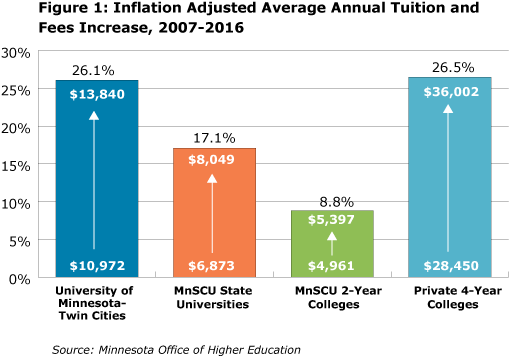
While tuition and fees were increasing much faster than inflation, median earnings for Minnesota workers did not keep pace, even for those with college degrees. Obviously the Great Recession greatly affected income growth during this period. Even in the decade prior, tuition and fees rose faster than median earnings. In other words, the cost of higher education increased faster than the growth in wages for people with college degrees.
As the cost of attending college has increased, so has the share of Minnesotans with student loan debt. More telling is the amount and share of Minnesotans with severely delinquent student loan debt. With about one in nine higher education borrowers now behind on payments, it appears that there is not enough awareness about the cost of education or a misperception of its financial benefit (see Figure 2).
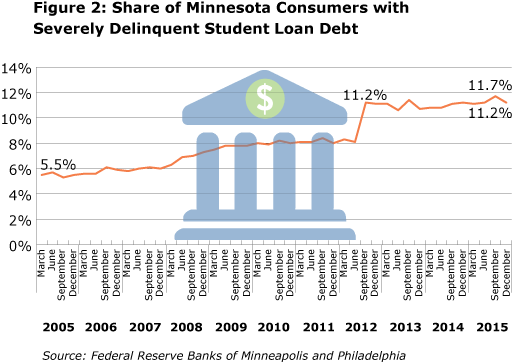
This basic question quickly becomes complex, since the method of financing higher education has a profound effect on the total cost and the lifetime benefit gauged in net terms. An easy process to determine the total cost of attending college is to multiply the average annual cost by the amount of years needed to complete the desired degree. The typical annual cost of attending college full time for the 2015-2016 school year in Minnesota ranged from $18,335 at a two-year state college to $48,265 at private four-year colleges. Using these estimates, a simple calculation of the total cost to attain a four-year degree at a state university would be $20,733 x 4 years = $82,932 (see Figure 3).
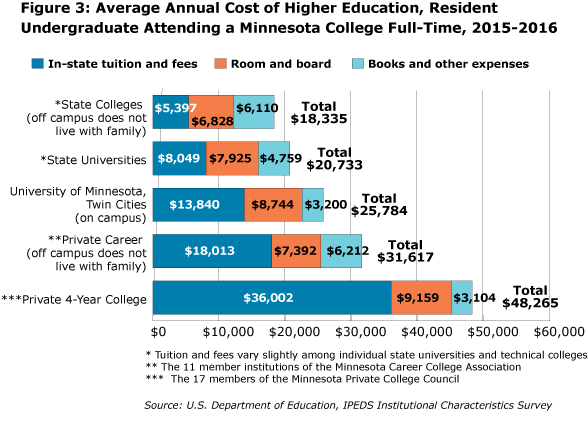
In 2014, however, only 36.2 percent of full-time, first-time students at public four-year institutions in Minnesota graduated within four years with a bachelor’s degree from the same school where they started. Fifty-five percent graduated within five years and 63 percent within six years.
Extended enrollment becomes even more likely if students aren’t sure about what careers and programs to pursue. So a more realistic estimate might be to plan for at least one extra year to complete a bachelor’s degree. Some programs (such as engineering) require students to take specific classes within the first few semesters in order to graduate on time. Waiting until the second year to nail down a specific major could prove costly.
Financial aid also needs to be considered. In the 2013-2014 school year, 49 percent of students attending state universities received some amount of grant aid, with an average amount of $4,591.
Table 1 illustrates the average net cost of education at various institution types in annual terms and the total net cost of completing on time, as well as taking an extra year to graduate. The net cost includes tuition and fees, books and supplies, and living expenses, but it also deducts the typical amount received in grants and scholarships.
| Net Cost of Higher Education for First-Time, Full-Time Undergraduates in Minnesota, 2013-2014 | ||||
|---|---|---|---|---|
| Institution Type | Average Annual Net Cost | Completing On-Time | Completing In One Extra Year | |
| 2-Year | State College | $14,000 | $28,000 | $42,000 |
| Private For-Profit 2-Year | $22,900 | $45,800 | $68,700 | |
| 4-Year | Public 4-Year | $17,200 | $68,800 | $86,000 |
| Private Not-For-Profit 4-Year | $24,300 | $97,200 | $121,500 | |
| Private For-Profit 4-Year | $21,400 | $85,600 | $107,000 | |
| Source: Minnesota Office of Higher Education | ||||
Federal student loans are another major part of financial aid. In the 2013-2014 school year, 52 percent of all undergraduates received federal student loans averaging $6,990. Federal loans do not decrease the cost of higher education and only defer payment.
Although the numbers might look shockingly high, most students graduate with considerably less student loan debt than the total net cost to complete their degree on time. Education also can be funded by working while enrolled or through work-study programs, family funding and 529 plans, among other sources.
Students also can cut the amount of debt they accumulate through less expensive housing, meals and transportation arrangements.
The current total borrowing limit for dependent undergraduate students tops out at $31,000, roughly the same as the average loan debt in 2014 of $31,579. Borrowing the full federal loan limit of $31,000 has a substantial impact on the quality of life and discretionary income available for graduates starting their careers.
For example, using an average debt load of $31,579, interest rates of 6.8 percent and a 20-year term, the total cost of the loan would amount to almost $58,000 due to the additional $25,700 paid in interest. Using those terms, a graduate's monthly payment would be $241.05 over 20 years. More attention and education placed on the real cost of loans could help keep potential borrowers from over-extending their finances for education and other purchases.
Of course, understanding the cost of education is only one side of the equation. The other side is the return.
DEED's Graduate Employment Outcomes (GEO) tool can help potential students find out how much income graduates with specific majors and award levels earn. The tool enables them to compare the costs of college with the typical earnings of graduates from the programs of study they are considering.
Until recently, post-graduation income was largely a guesstimate, based on wage estimates of established workers. Fortunately, the GEO tool provides potential students with the data necessary to quantify the risk associated with borrowing money to finance higher education.
According to GEO, recent graduates completing a certificate or diploma program could expect to earn almost $36,000 within 24 months of graduating if they found full-time, year-round employment. Associate degree completers earned a median wage of $38,385 within 24 months of graduation, while bachelor's degree earners could expect over $41,000 by their second year working (see Figure 4).
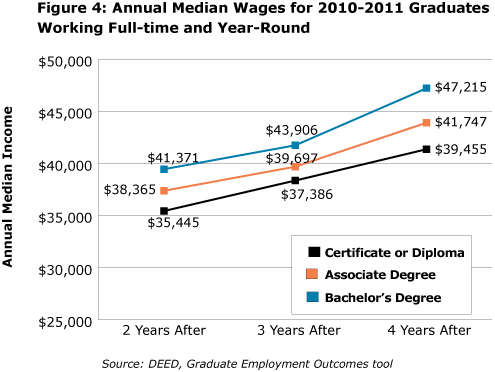
Since the data in Figure 4 represent the median, however, students and their parents should keep in mind that half of the graduates make more than the published wages and the other half make less. Although knowing the median income earned at each award level is beneficial, finding the details for a specific program is much more useful when guiding financial decisions.
As illustrated in Figure 5, earnings for bachelor's degree holders range from a median of $32,000 a year for those who majored in parks, recreation and leisure studies to nearly $66,000 for those with chemical engineering degrees.
It should be noted that the share of parks, recreation and leisure studies graduates working full-time and reporting wages in every quarter throughout the year is substantially lower than all other bachelor's degree programs combined. On the other hand, the ratio of chemical engineering graduates who are employed full-time and year-round is significantly higher than typical. This pattern holds true for at least the second, third and fourth years after graduating.
Students deciding between different degree levels, programs or institutions would be wise to recognize that increasing the length of time attending higher education does not always correlate to increased income after graduation. Graduates from the highest-earning programs of study within each award level (certificate, associate or bachelor's degree) have similar wages and wage growth.
Figure 5 demonstrates how deciding on the type of program to pursue can yield exceptional returns from higher education, while the same investment may not pay off as handsomely in lower-earning programs. Students should also consider the extra years of income earned for shorter programs, as well as the cost to delay career opportunities for longer programs.
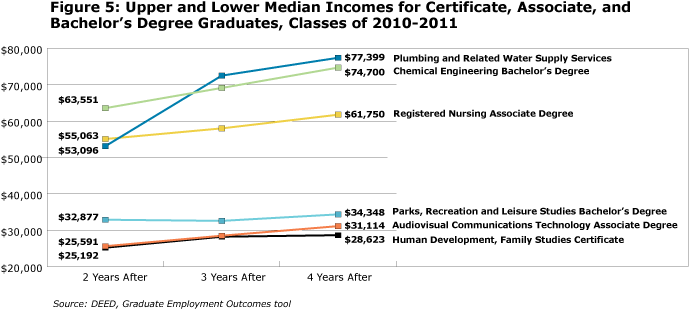
Enrolling and paying for education is best accomplished with clear direction and goals. As obvious as this may seem, graduate income data can provide guidance on whether it makes sense to borrow for education. Graduates from programs with higher median income after completion should be able to afford higher loan payments.
Equally important to financial stability is the expected cost of living. The basic cost to live in Minnesota for a single worker with no children is $30,084, according to DEED's Cost Of Living tool. Potential students can use the cost of living estimates at their current or expected family composition (including a spouse and children), then add the typical or expected monthly student loan payments to help plan funding for higher education and possibly prevent over-borrowing.
The example in Figure 6 uses the median income earned 24 months after graduating for bachelor's degree graduates from the class of 2013 who were employed full-time and year-round. It subtracts the basic cost to live in Minnesota for a single worker with no children and subtracts the estimated monthly student loan payment using the average student loan amount in Minnesota. The remaining disposable income represents an amount beyond the basic needs cost for a single person in Minnesota.
Individualized data should be substituted where possible, including changing the cost of living for different family compositions and the anticipated income earned by graduates from specific programs and colleges using the Graduate Employment Outcomes tool.

Higher education remains an excellent vehicle to expand employment horizons. The financial costs and benefits vary, however, depending on individual choices. The cost greatly depends on the type of institution attended, length of enrollment, financial aid and how much money is borrowed. The benefits depend on the program of study pursued, the rigor of job search after graduation and, overall, the ability to find a job that will reward the education attained. The best return on education will come by increasing income or decreasing the cost.
Some ways to increase the return on education include the following:
Education is freeing in many ways, and knowledge is power. Students, however, should plan carefully so that they don't end up financially powerless. Knowledge gained through higher education should promote financial success, and learning "how to think" helps students make better life decisions.
Yet, over-borrowing to acquire that knowledge can take away financial freedom and leave students feeling powerless over their financial future. Therefore, balancing the costs of education with the benefits is a worthwhile exercise.
Source: U.S. Department of Education, IPEDS Student Financial Aid Survey Average Student Debt: The Institute for College Access and Success (TICAS)